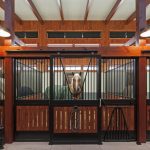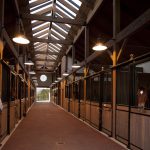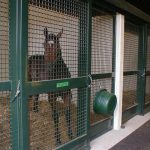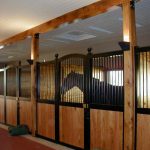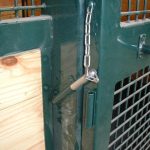Since our previous post about Barn Doors was such a hit and we had some questions about stall door design, I am going to share some of my tips and opinions about stall doors today. At the end, you can look at photos of stall doors in some of the stables we have designed.
For basic stall design, I always advocate for the door to be placed in the middle of the stall front. This allows both corners to be open for hanging buckets or placing feed. It also creates less of a blind spot than if placed in the corner. In general, you want your stall door to slide to the left. If you have a horse in your right hand, this leaves your left hand free to open the door. Once in the stall, you are able to easily close the door with your free hand. This is just one example of efficient and safe design, as the handler does not have to change hands or be thrown off balance by moving doors.
When designing your own barn, owners must choose between swinging and sliding stall doors. I always recommend sliding stall doors, for both safety and efficiency. As mentioned briefly last time, swinging doors present safety concerns for two reasons. First, if left unlatched, wind can easily blow the door open and the action or resultant noise can spook and cause injury for the horse. Second, a sliding door enables you to leave the door open/closed and allows you to see immediately if the door is open from farther away. This also saves the time of opening and shutting the door every time the horse goes out. In a barn with many horses that are going in and out throughout the day, sliding is simply more efficient.
For latching, I always recommend pin latches. I have found these to be the best option, as they do not extrude from the stall door. Keep in mind if you use yoke gates, one needs to put the pin latch half way between the yoke gate and the floor at a minimum. Otherwise, you can have the issue of a clever horse letting itself out.
People have asked what material I advise for doors; in general, I recommend a steel frame door. If you want the look of wood, then you can insert a wood panel in a steel frame. I generally prefer doors to have an open top and bottom, as achieved by either bars or mesh. This enables both ventilation and visibility. Of course, there are advantages and disadvantages to both. Mesh, while stronger, can collect dust on the horizontal bars. (Make sure to always face the horizontal side of the mesh out, so smaller horses can’t climb up it). On the other hand, vertical bars, if not placed with a 2 inch or less spacing, can allow horses to get their hooves stuck and injured. Some people also dislike the aesthetics of the bars. All in all, this is a personal preference. The choice can be all bars, all mesh, or a combination of both (which is usually mesh below for strength and bars above for visibility). Incidentally, a bedding guard across the bottom of the stall door is a nice, simple feature that helps keep the bedding from falling through the lower panel of the door.
Many times, I recommend yoke gate doors, as this allows the horse to see its surroundings and communicate with fellow animals (especially if both side walls are solid). However, these types of gates are best if used with aisles that are 14’ or wider. Otherwise, you get issues when some horses do not appreciate the ‘communication’ that is happening in front of their stall. Always buy some filler panels for the yoke gates, as not every horse can be social. In general, I would recommend having enough filler panels for half your total stalls. This way there are always some on hand.
The yoke gate also fulfills a utilitarian function. In lieu of a hay access door or the action required to open the stall door to go into the stall, one can easily place a flake of hay in the stall, provided you feed hay from the floor. Yoke gates are very comforting to the owner as well. We all know how nice it is to look down an aisle and see our horses looking out of their stall. The same is true on exterior stall doors and/or windows. However, yoke gates are not for everyone and in the end it’s a matter of personal preference. I prefer the removable yolk gate panels, instead of the ones that hinge and hang down, because they leave the stall front cleaner and less cluttered. Also, there is less noise created when the door is opened and shut, or when an impatient horse decides to kick the door. There are other variations on the design of yoke gates that I will cover in perhaps another article later.
Finally, I always recommend Dutch doors to the outside. These are a major way to increase and control ventilation into your barn and take care of the health of your horse. The two leaves provide you options for full opening or half opening depending on the weather conditions. By opening the doors, you can reduce the ammonia gas and the odor that comes with it. The ventilation moves the gas up and out through vertical ventilation. At the same time, the sunlight that enters the stall is able to remove bacteria from the air and stall, while reducing the production of ammonia gas (which requires dark, damp locations).
I also advocate for a double door system, meaning you have the solid Dutch door on the outside with an interior door (a steel door of bars, mesh, or a combination of both). In this case, as it is being used mainly for emergency, the interior door can be either swinging or sliding. Swinging is good because nothing protrudes from the door (such as floor guides or rollers). However, it can be problematic if you are trying to release a frenzied horse as the door opens into the stall. Many of you have surely seen Dutch doors being used where the top is open and the bottom is left closed, with no second door in sight. This does not take full advantage of the door! Yes, some sort of webbing could be placed across the door, but that does not inhibit a very determined horse. This is why I advocate for double doors.
Now for some examples! Many of our projects have used Lucas Equine Stall Systems. They are well made and they can custom design the stall system to fit virtually any owner’s needs or aesthetic desires. Keep scrolling down to see some pictures of stall doors in stables we have designed.


